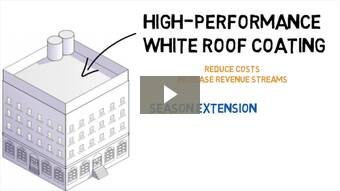Urban Heat Islands
Heat-related health issues, increased demand on energy, and decreased water quality. Those are just a few of the effects of urban heat islands. And it is another reason we need to build smarter and better cities.
Fast Fact: The urban heat island phenomenon was first discovered in the early 1800s in London.
Urban heat test
Urban heat test
The size, background ecology and development patterns of a city combine to create massive heat islands. Scientists at NASA have been studying them. Watch this short video to see what they have found.
Surface vs. atmospheric
Surface vs. atmospheric
According to the EPA, "on a hot, sunny summer day, the sun can heat dry, exposed urban surfaces, such as roofs and pavement, to temperatures 50-90°F (27-50°C) hotter than the air."
Atmospheric urban heat islands, on the other hand, "are often weak during the late morning and throughout the day and become more pronounced after sunset due to the slow release of heat from urban infrastructure." The EPA says that the annual mean air temperature of a city with 1 million people or more can be 1.8-5.4°F (1-3°C) warmer than its surroundings. It's worse on a clear, calm night, as the temperature difference can be as much as 22°F (12°C).
The two big factors
The two big factors
The main contributing factors of urban heat islands are:
- 1
Increased surface sealing due to expansion of transport infrastructure (roads and highways). Essentially, that means rainwater cannot percolate naturally to enable evaporative cooling.
- 2
Increased building on greenfield sites. Dense buildings interfere with airflow and the natural circulation of air in urban environments, with the result that rising hot air masses are not carried away.
Heat and humans
Heat and humans
A few degrees can make a big difference to humans.
- 1
People living in cities can experience higher electricity bills than people in the suburbs or rural areas during summer months. Higher demand on the power grid can cause blackouts, especially during heat waves.
- 2
Runoff from storms passes over warm surface structures, bringing the heat with it as it flows into local streams, rivers and lakes, increasing air temperature. Disease-causing bacteria can easily grow under these conditions.
- 3
The higher air temperature adds to pollution, potentially causing asthma in children, whose respiratory systems are still developing. Plus, heat-stroke, exhaustion, and other associated heat-related issues can affect health.
What can we do?
What can we do?
It's not an easy problem to correct, and much of the solution involves how we approach development and sprawl, incorporating greenery into design, managing vehicle emissions and the infrastructure needed to support the estimated three billion people that will live in urban areas by 2050.
In short, it will take all of us. Here's some of what BASF is doing.
Better concrete and pavement
Elastopave®, a binder product developed by BASF, will not hold and absorb heat like conventional pavement materials. And it can be used to create water-permeable, hard-landscaping surfaces, minimizing water usage and rainwater harvesting.
It's also easy to repair, when compared to concrete or asphalt, and helps prevent tree roots from cracking the pavement-which is another way to combat urban heat islands: planting more trees.
Cool pigments, cool buildings
Cool pigments, cool buildings
BASF offers a full range of pigment solutions for solar heat management-each with improved total solar reflectance (TSR) values, which can result in a temperature decrease of up to 20°C on the surface.
This decrease not only provides benefits from a comfort perspective, but the lower temperature also results in reduced demand from the material itself.
Chemistry of Innovations podcast
Cooler surfaces with special color pigments
Cool downloads
Additional reading and resources
Additional reading and resources

Stay Informed |
|
|
Sign up for the latest BASF construction news. |

Help me on my project |
|
-
General
Information -













